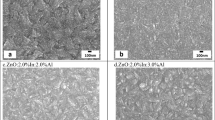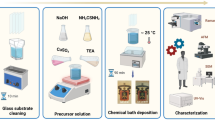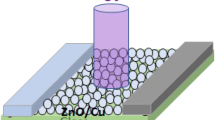Abstract
The thin films of CuO with yttrium as a dopant at 1, 3, and 5wt% are prepared using a simple and economic JNS spray pyrolysis technique at the optimized substrate temperature of 600 °C. The impact of yttrium doping on the structural, optical, and electrical properties of CuO thin films has been investigated. The structural properties of synthesized films are analyzed using X-ray diffraction (XRD) studies, which confirmed that all the films are polycrystalline with a monoclinic structure. Scanning electron microscopy was analyzed to study the changes that occurred in the morphology of the sample with the concentration of yttrium doped. The optical characteristics of the films are investigated using a UV–Vis absorption spectrophotometer. Y3+ ion causes the fall of absorption in the visible region. The optical bandgap of the pure and yttrium-doped CuO thin films are calculated from the Tauc’s plot of their absorption spectrum. The higher the concentration of the yttrium, larger the bandgap value indeed. The variation in the electrical behavior of the prepared films with the yttrium concentration has been investigated using a Keithley electrometer two-probe setup. The average conductivity of the films increases as the yttrium content increases. The p-YCuO/n-si diodes with 1%, 3%, and 5% yttrium doped on CuO are fabricated and their ideality factors (n) and potential barrier values (Φ) are calculated using the JV method. The presence of Y3+ ions makes the rectification behavior of the diodes better.










Similar content being viewed by others
Data availability
The datasets generated during and/or generated during the current study are available from the corresponding author on reasonable request.
References
S. Raheleh, H. Abbas, O. Amiri, M. Salavati-niasari, Synthesis, characterization and application of Co / Co 3 O 4 nanocomposites as an effective photocatalyst for discoloration of organic dye contaminants in wastewater and antibacterial properties. J. Mol. Liq. 337, 116405 (2021). https://doi.org/10.1016/j.molliq.2021.116405
S. Raheleh, Y. Davood, G. Masoud, Photo-degradation of organic dyes : simple chemical synthesis of Ni ( OH ) 2 nanoparticles, Ni / Ni ( OH ) 2 and Ni / NiO magnetic nanocomposites. J. Mater. Sci. Mater. Electron. (2015). https://doi.org/10.1007/s10854-015-3882-6
https://www.sciencedirect.com/science/article/abs/pii/S0360319922008126#!, “Green synthesis of DyBa2Fe3O7.988/DyFeO3 nanocomposites using almond extract with dual eco-friendly applications: Photocatalytic and antibacterial activities,” 47(31), 14319–14330, Apr. 2022.
S. Raheleh, M. Masjedi-arani, ScienceDirect Hydrothermal synthesis of DyMn 2 O 5 / Ba 3 Mn 2 O 8 nanocomposite as a potential hydrogen storage material. Int. J. Hydrogen Energy 44(43), 24005–24016 (2019). https://doi.org/10.1016/j.ijhydene.2019.07.113
Y. Ohya, S. Ito, T. Ban, Y. Takahashi, Preparation of CuO thin films and their electrical conductivity. Key Eng. Mater. 182(181–182), 113–116 (2000). https://doi.org/10.4028/www.scientific.net/kem.181-182.113
P. Cao, Y. Bai, Structural and optical properties of ZnCoO thin film prepared by electrodeposition. Adv. Mater. Res. 781–784, 323–326 (2013). https://doi.org/10.4028/www.scientific.net/AMR.781-784.323
“Spin Coated Multilayered Cupric Oxide Thin Films and their structural properties P. Samarasekara and N.G.K.V.M. Premasiri Department of Physics, University of Peradeniya, Peradeniya, Sri Lanka,” (pp. 1–10)
H. Qamar-Kane, A. Fall, L. Diop, New MX 2 oxalato polynuclear adducts (M = Cd, Hg, Zn; X = Cl, Br): synthesis and infrared study. Sci. Study Res. Chem. Chem. Eng. Biotechnol. Food Ind. 12(4), 357–362 (2011)
A. Tombak, M. Benhaliliba, Y.S. Ocak, T. Kiliçoglu, The novel transparent sputtered p-type CuO thin films and Ag/p-CuO/n-Si Schottky diode applications. Results Phys. 5, 314–321 (2015). https://doi.org/10.1016/j.rinp.2015.11.001
G. Palareti et al., Comparison between different D-Dimer cutoff values to assess the individual risk of recurrent venous thromboembolism: analysis of results obtained in the DULCIS study. Int. J. Lab. Hematol. 38(1), 42–49 (2016). https://doi.org/10.1111/ijlh.12426
Q.J. Liu, N.C. Zhang, Y.Y. Sun, F.S. Liu, Z.T. Liu, Structural, mechanical, electronic, optical properties and effective masses of CuMO2 (M = Sc, Y, La) compounds: first-principles calculations. Solid State Sci. 31, 37–45 (2014). https://doi.org/10.1016/j.solidstatesciences.2014.02.017
S.R. Yousefi, O. Amiri, M. Salavati-niasari, Control sonochemical parameter to prepare pure Zn 0 . 35 Fe 2 . 65 O 4 nanostructures and study their photocatalytic activity. Ultrason. Sonochem. (2019). https://doi.org/10.1016/j.ultsonch.2019.104619
I. Atribak, A. Bueno-López, A. García-García, Role of yttrium loading in the physico-chemical properties and soot combustion activity of ceria and ceria-zirconia catalysts. J. Mol. Catal. A Chem. 300(1–2), 103–110 (2009). https://doi.org/10.1016/j.molcata.2008.10.043
A. Tombak, S. Baturay, T. Kilicoglu, Y.S. Ocak, Optical, electrical, and morphological effects of yttrium doping of cadmium oxide thin films grown by ultrasonic spray pyrolysis. J. Electron. Mater. 46(4), 2090–2096 (2017). https://doi.org/10.1007/s11664-016-5134-9
M. A. Kaiyum and N. Ahmed, “Yttrium Doped TiO2 Thin Film for Gas Sensing Application Prepared by Spin Coating Method,” 2020.
S. Baig, A.D. Hendsbee, P. Kumar, S. Ahmed, Y. Li, Yttrium-doped CuSCN thin film transistor: synthesis and optoelectronic characterization study. J. Mater. Chem. C 7(46), 14543–14554 (2019). https://doi.org/10.1039/c9tc05371a
N. Jhansi et al., Impact of substrate temperature on structural, electric and optical characteristics of CuO thin films grown by JNS pyrolysis technique. SILICON (2022). https://doi.org/10.1007/s12633-021-01578-3
D. Dastan, Effect of preparation methods on the properties of titania nanoparticles: solvothermal versus sol – gel. Appl. Phys. A (2017). https://doi.org/10.1007/s00339-017-1309-3
D. Dastan, S. Leila, P. Nandu, Characterization of titania thin films grown by dip-coating technique. J. Mater. Sci. Mater. Electron. (2016). https://doi.org/10.1007/s10854-016-4985-4
X. Li, X. Lian, F. Liu, Rear-end road crash characteristics analysis based on chinese in-depth crash study data. CICTP 2016 - Green Multimodal Transp. Logist. - Proc. 16th COTA Int. Conf. Transp. Prof. (2016). https://doi.org/10.1061/9780784479896.140
A.J. Kulandaisamy, V. Elavalagan, P. Shankar, G.K. Mani, K.J. Babu, J.B.B. Rayappan, Nanostructured cerium-doped ZnO thin film – A breath sensor. Ceram. Int. 42(16), 18289–18295 (2016). https://doi.org/10.1016/j.ceramint.2016.08.156
K. Sakai et al., Defect centers and optical absorption edge of degenerated semiconductor ZnO thin films grown by a reactive plasma deposition by means of piezoelectric photothermal spectroscopy. J. Appl. Phys. (2006). https://doi.org/10.1063/1.2173040
Y. Ma, J. Zhang, B. Tian, F. Chen, L. Wang, Synthesis and characterization of thermally stable Sm, N co-doped TiO2 with highly visible light activity. J. Hazard. Mater. 182(1–3), 386–393 (2010). https://doi.org/10.1016/j.jhazmat.2010.06.045
S. Raheleh, Y. Mojgan, G. Omid, Z. Marzhoseyni, P.M.M. Hajizadeh-, scheme heterojunction nanocomposite with enhanced photocatalytic and antibacterial activities. J. Am. Ceram. Soc. (2021). https://doi.org/10.1111/jace.17696
D. Dastan, N.B. Chaure, Influence of surfactants on TiO 2 nanoparticles grown by sol-gel technique. Int. J. Mater. Mech Manuf. 2(1), 21–24 (2014). https://doi.org/10.7763/IJMMM.2014.V2.91
D. Dastan, Nanostructured anatase titania thin films prepared by sol-gel dip coating technique. J. At. Mol. Condens. Matter Nano Phys. 2(2), 109–114 (2015). https://doi.org/10.26713/jamcnp.v2i2.331
T. Takagahara, K. Takeda, Theory of the quantum confinement effect on excitons in quantum dots of indirect-gap materials. Phys. Rev. B 46(23), 15578–15581 (1992). https://doi.org/10.1103/PhysRevB.46.15578
K. Shan, Z.Z. Yi, X.T. Yin, D. Dastan, H. Garmestani, Conductivity and mixed conductivity of a novel dense diffusion barrier and the sensing properties of limiting current oxygen sensors. Dalton Trans. (2020). https://doi.org/10.1039/D0DT00496K
K. Shan, Z. Yi, X. Yin, D. Dastan, H. Garmestani, “Y-doped CaZrO3/Co3O4 as novel dense diffusion barrier materials for a limiting current oxygen sensor. Dalton Trans. (2020). https://doi.org/10.1039/d0dt01159b
A.S. Baig, P. Kumar, J. Ngai, Y. Li, S. Ahmed, “Yttrium doped copper (II) oxide hole transport material as efficient thin film transistor. ChemPhysChem (2020). https://doi.org/10.1002/cphc.202000005
M. Balaji, J. Chandrasekaran, M. Raja, Role of substrate temperature on MoO3 thin films by the JNS pyrolysis technique for P-N junction diode application. Mater. Sci. Semicond. Process 43, 104–113 (2016). https://doi.org/10.1016/j.mssp.2015.12.009
K. Shan, Z. Yi, X. Yin, D. Dastan, F. Altaf, Mixed conductivity evaluation and sensing characteristics of limiting current oxygen sensors. Surfaces Interfaces 21, 100762 (2020). https://doi.org/10.1016/j.surfin.2020.100762
D. Dastan, S.W. Gosavi, N.B. Chaure, “Studies on electrical properties of hybrid polymeric gate dielectrics for field effect transistors. Macromol. Symp. (2015). https://doi.org/10.1002/masy.201400042
M. Balaji, J. Chandrasekaran, M. Raja, S. Rajesh, Structural, optical and electrical properties of Ru doped MoO3 thin films and its P-N diode application by JNS pyrolysis technique. J. Mater. Sci. Mater. Electron. 27(11), 11646–11658 (2016). https://doi.org/10.1007/s10854-016-5300-0
K. Shanmugasundaram, P. Thirunavukkarasu, M. Balaji, Effect of Sn doping on the structural, optical, electrical properties and Diode characteristics of WO3 thin films deposited by jet nebulizer spray technique. Mater. Today Proc. 18, 1648–1657 (2019). https://doi.org/10.1016/j.matpr.2019.05.261
M. Balaji, J. Chandrasekaran, M. Raja, Characterization of WMoO3 thin films and its n-WMoO3/p-Si junction diodes via JNS pyrolysis technique. Zeitschrift fur Phys. Chemie 231(5), 1017–1037 (2017). https://doi.org/10.1515/zpch-2016-0861
Funding
The authors declare that no funds, grands or other supports were received during the preparation of this manuscript.
Author information
Authors and Affiliations
Contributions
All authors contributed to the study conception and design. Material preparation, data collection and analysis were performed by NJ, DB, RR, and RJ. The first draft of the manuscript was written by NJ and all authors commented on previous versions of the manuscript. All authors read and approved the final manuscript.
Corresponding author
Ethics declarations
Competing interest
The authors have no relevant financial or non financial interest to disclose.
Additional information
Publisher's Note
Springer Nature remains neutral with regard to jurisdictional claims in published maps and institutional affiliations.
Rights and permissions
Springer Nature or its licensor holds exclusive rights to this article under a publishing agreement with the author(s) or other rightsholder(s); author self-archiving of the accepted manuscript version of this article is solely governed by the terms of such publishing agreement and applicable law.
About this article
Cite this article
Jhansi, N., Balasubramanian, D., Raman, R. et al. Impact of yttrium on structural, optical and electrical behavior of CuO thin film prepared by JN spray pyrolysis technique for diode application. J Mater Sci: Mater Electron 33, 22785–22797 (2022). https://doi.org/10.1007/s10854-022-09046-3
Received:
Accepted:
Published:
Issue Date:
DOI: https://doi.org/10.1007/s10854-022-09046-3




